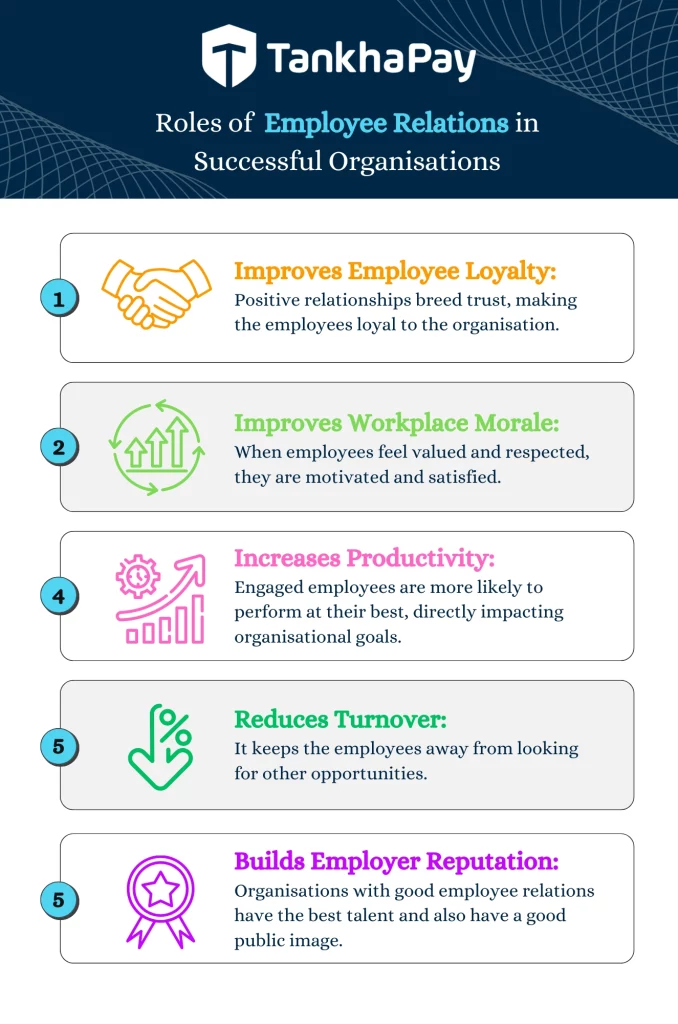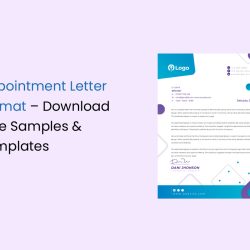Employee relationships are crucial in ensuring that the workplace is productive and harmonious. When properly managed, it leads to trust, cooperation, and satisfaction, all contributing to organisational success. What, then, is employee relations, and why does it matter? This all-encompassing guide unpacks the concept, explains why it matters, and shares actionable strategies for effective employee relations.
What is Employee Relations?
Employee relations is a broad term referring to an organisation’s activities in dealing with the relationship of its employees to the employer to build a productive, fair, and engaging workplace. It has been associated with problems in the workplace, open communication, mutual respect, and trust. In most organisations, it is the human resources department’s duty; however, some organisations designate a professional employee relations manager.
Importance of Employee Relations
- More Productivity: If the workers are valued, heard, and respected, they will automatically be highly engaged and productive. If the workforce is motivated, the possibility of achieving performance expectations will increase.
- Better Employee Retention: Good employee relations lead to high job satisfaction, hence lower turnover. The employees will stay put if they have an attachment to the organisation.
- Fewer Workplace Conflicts: An open communication culture minimizes workplace conflicts by addressing the problems at hand.
- Legal and Ethical Compliance: Good employee relations guide organisations through labour laws and ethical standards. This reduces the possibilities of litigation and keeps the workplace just.
- Better Teamwork: Good relations between the workers encourage teamwork, innovation, and cooperation. The well-coordinated teams ensure better results.
Main Elements of Employee Relations
- Communication: Open and regular communication will assist in understanding the needs of employees, addressing their issues, and keeping everyone on the same page about goals and organisational changes.
- Trust and Respect: It will make them feel valued and appreciated, by building mutual trust and respect. For example, this can be attained by policies, which are fair and consistency in leadership behaviour as well as open communication.
- Conflict Resolution: An organisation should have proper procedures in place for addressing disputes promptly and equitably. Effective conflict management prevents minor issues from becoming major problems.
- Reward and Recognition: Employee achievements enhance the morale and loyalty of the employees. It is felt when employees are appreciated. Feedback programmes, rewards, and success celebrations enhance a positive culture.
- Work-Life Balance: Satisfaction is maintained by supporting the comfort of employees by being flexible with policies, resources on mental health, and work-life balance.
Building Strong Employee Relations
- Open-Door Policy: Let the employees be free to express themselves and not be judged. This would make them have a culture of openness and accessibility.
- Employee Development: Provide opportunities for acquiring skills, training, and career advancement. Employees who are investing in the business will be committed.
- Celebrate Diversity and Inclusion: An inclusive workplace is where all the employees, regardless of their walks of life, are valued and respected. Diversity brings innovation and creativity.
- Routine Feedback: Constructive feedback at the right moment makes employees learn and become noted at work.
- Collaborative Environment: Teamwork can be encouraged through collaborative tools, cross-departmental projects, and team-building activities.
- Clear Policies and Expectations: A well-documented employee handbook ensures that everyone knows what is expected of them, what rights they have, and the company’s policies.
- Leverage Technology: The human resource management systems can be applied in activities such as employee feedback, performance review, and grievance handling. The process makes communication and problem-solving very efficient.
Roles of Employee Relations in Successful Organisations
Employee relations play a very important role in organisational success. Here’s how:
- Improves Employee Loyalty: Positive relationships breed trust, making the employees loyal to the organisation.
- Improves Workplace Morale: When employees feel valued and respected, they are motivated and satisfied.
- Increases Productivity: Engaged employees are more likely to perform at their best, directly impacting organisational goals.
- Reduces Turnover: It keeps the employees away from looking for other opportunities.
- Builds Employer Reputation: Organisations with good employee relations have the best talent and also have a good public image.
Examples of Employee Relations Issues
Knowing the common employee relations issues allows an organisation to prepare and address them more effectively. Here are five examples:
Work Conflicts
Conflicts among employees arise from poor communication. Conflicts must be addressed immediately to ensure the environment remains positive.
Workplace Bullying
Unchecked bullying leads to low morale, absenteeism, and reputational loss. The employer has to take complaints seriously and ensure prompt investigation and implementation of anti-bullying policies.
Workplace Safety
Workplace injuries and financial loss can be the results of safety issues. Preventive safety measures protect employees and avoid liabilities.
Disagreements
It would most certainly develop issues concerning employee trust and compliance. These can be solved by discussing the discrepancy and improving their systems of tracking.
Pay Rise Demand
Ignoring the requests for pay raises may result in dissatisfaction and turnover. The employer should think about the requests and come up with alternatives if the raises cannot be granted.
How to Handle Employee Relations Issues
Effective handling of employee relationship issues requires proactive and strategical approaches. This is how organisations work them through appropriately:
Employee Relations Strategy
A good strategy aligns the needs of employees with organisational goals. Some of the KPIs to be monitored are:
- Employee satisfaction ratings
- Complaints filed and their response time
- Recognition and reward metrics
- Benefit comparison with and compensation industry averages
Listen to Employee Feedback
Listening to the issues of employees builds trust and reveals the problems. Active listening refers to giving undivided attention to both verbal and non-verbal communication.
Educate and Communicate
Clearly stated policies and expectations prevent miscommunication. It is consistent and fair. In return, employees respect that fairness.
Ensure Compliance
All the records of employee interactions and decision-making should be maintained. Documentation can be a saviour for the organisation during lawsuits or disputes.
10 Strategies of Employee Relations
- Develop Trust: Developing openness and transparency in the interaction of the employees with the management.
- Collaboration: Encourage teamwork and mutual respect.
- Tackle Problems Anticipatively: Solve all the possible problems before they occur.
- Appreciate People’s Work: Explain to them how much one appreciates their efforts.
- Allow Feedback: Provide as many ways for your employees to give feedback.
- Training: Educate your managers and workers with skills related to communication and conflict resolutions.
- Clearly Define Expectations: Outline roles, responsibilities, and policies.
- Maintain Fairness: The implementation of rules should be balanced and fair to all employees.
- Support Wellbeing: Support the physical and mental health of employees through programmes.
- Review Policies Regularly: Policies should be reviewed regularly and updated according to the industry standards.
Employee Relations Examples
Effective employee relations are evident throughout the employee lifecycle. There are eight examples of this:
- Employee Onboarding: The onboarding process marks a great employee-employer relationship. This process involves making the recruits feel welcomed while offering them all the necessary training and putting them into the team.
- Conflict Management: There are formal procedures for resolving disputes so that disputes are resolved reasonably and efficiently.
- Absenteeism: Analysing the root causes of excessive absences helps organisations in supporting the same and creating better work structures.
- Insubordination: Insubordination is that which requires clear expectations about behaviour, training in communication, and mutual respect.
- Employee Misconduct: There must be policies, reporting mechanisms, and clear and prompt actions against misconduct.
- Employee Wellbeing: Wellness programmes such as mental health days or gym memberships demonstrate a concern for employee welfare.
- Workplace Safety: An informed employee is the crown jewel of a culture that cares about its safety policy.
- Labour Relations: Communication transparency with unions helps to make good labour relations and ward off conflicts.
What Does an Employee Relations Job Entail?
An employee relations manager is responsible for maintaining harmony in the workplace. Some of the key duties include:
- Mediation: Acting as a liaison between employees and management to resolve disputes.
- Policy Formulation: Policies are advice given and enforced regarding compensation, benefits, work-life balance, and working hours.
- Conflict Resolution: Resolve workplace conflicts promptly to avoid escalation.
- Employee Advocacy: Representing employee concerns and ensuring that the issues are dealt with fairly.
Conclusion
Any productive workplace would first and foremost be based on employee relations. An organisation that creates a basis of trust, openness, and proactive discussion regarding problems creates a good working environment whereby employees are respected and involved.
Employee relations will top the priorities as the workplace evolves, attracting and retaining the best talent, driving productivity, and achieving organisational success. This can be achieved if businesses adopt the strategies developed here to create an altruistic culture that benefits everyone involved. Join us at TankhaPay and improve your employee relations with tech-driven solutions!
Frequently Asked Questions about Employee Relations
Why is Employee Relations Important to Small Businesses?
To a small business, for the development and retention of the employees' strength to work cohesively for its survival with a high sense of morale is translated in direct proportion.
How Does Technology Help in Employee Relations?
HR software and tools can help make easy communication, track employee feedback, and analytics to proactively identify and address issues.
How Can Your Organisation Track the Employee Relations Strategy?
The good practices are employee achievements, clear communication, and professional development support.















